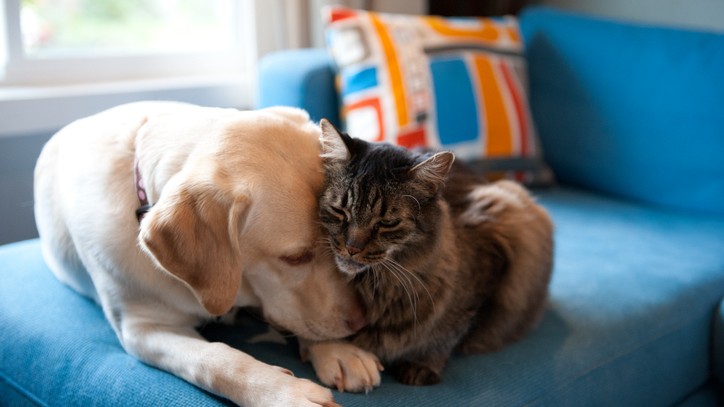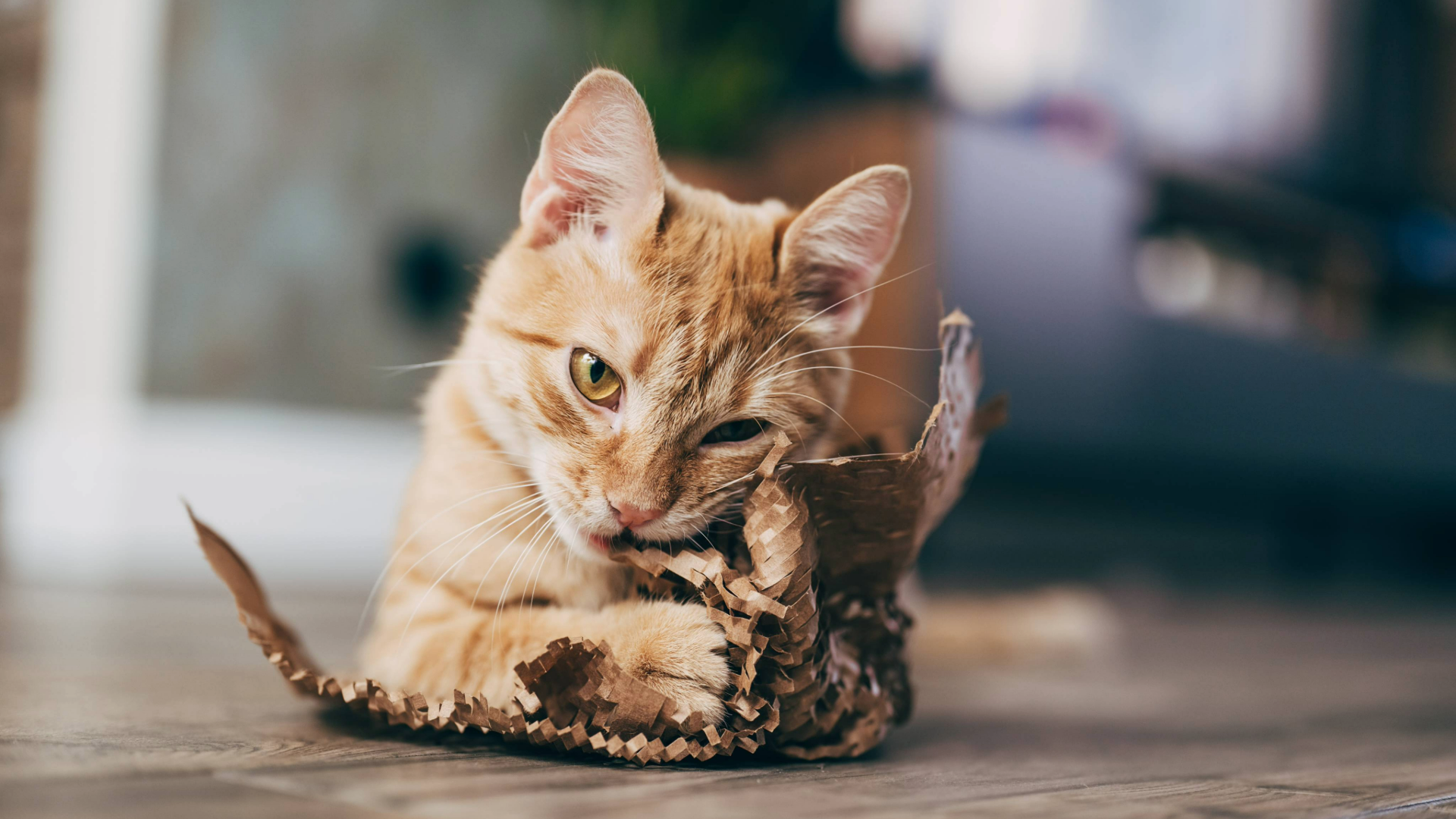Dogs and cats living together: Five dos and don’ts from a vet
Our tricks will help you to get your dogs and cats living together in perfect harmony

Whether the new addition is a sweet little kitten or an elderly rescue dog, there are some things you should know about cats and dogs living together. After all, cats and dogs are not naturally friends, so it’s important to do what you can to help them get along. Multi-pet harmony is possible, but there are a few tips and tricks that can help.
Should I get a cat if I have a dog (or vice versa)?
Of course, there are some considerations before you mix these two very different creatures. First and foremost, you need to be as confident as possible that they’ll get on. If you’re adopting a kitten or dog from a rescue, ask them if they get on with other animals. Many rescues will be able to ‘dog test’ a cat, or ‘cat test’ a dog, to see how they react. However, it’s important to remember that this test is just an indication of the pet’s attitude to other animals, and things might be different with different pets and in a different situation.
How will your current pet cope? Are they generally outgoing, with an easy personality? How do they react when people visit? Has your dog ever chased a cat, or are they a breed bred for hunting small creatures? If you’re adopting a young cat, it’s especially important to ensure that your dog doesn’t have a high prey drive, as your kitten will be vulnerable.
Why don’t cats and dogs get on?
Although it’s well known that cats and dogs don’t get on, many pets can live together in harmony. In fact, around 7% of UK households have a cat and a dog living together. However, dogs and cats do have some natural differences that make life together a little more difficult.
Firstly, cats are prey species, and dogs are a natural predator. In many countries, wild-living cat species of a similar size to our domesticated cats will be at risk from free-roaming wolves, so it’s natural for cats to be scared of dogs.
Secondly, there is some competition between the two species. Both want your attention, both see you as a source of food and companionship – so there is likely to be some competitiveness and they may even feel territorial towards one another.
Thirdly, although cats and dogs both communicate with scents and body language, they speak two languages. Like humans misinterpreting a dog’s yawn as boredom rather than fear, cats and dogs can struggle to read one another’s signals, making it hard for each species to ‘understand’ one another.
Sometimes cats and dogs can get on for years, but a change in the household such as a new baby, a vet visit, or a change of routine can upset the delicate balance. If this happens, reintroduce them as if you’re starting from scratch.
So, how can you help your dog and cat get on?
DO: Introduce dogs and cats carefully
At first, separate the house into two so that the newcomer can get used to their surroundings before introducing them. You can swap a blanket or bed between the two areas so that each can get used to the scent of the other. Play with both your pets before the first meeting, and take your dog for a long walk so that they’re tired and less excitable. The goal of the first meeting is to keep both pets calm, safely apart, and in a positive mindset (food helps!). The first meeting should be short – no more than a few minutes – and they should then be separated again.
DO: Provide lots of positive reinforcement for your dog
When you introduce your pets, have your dog on a lead. Although cats that are experienced with dogs might stand their ground when approached, the vast majority will flee at first. Many dogs will chase something that runs away, so be prepared for this. Whenever your dog ignores the cat, or shows calm behaviour, reward them via positive reinforcement. Ideally, you want your dog to be aware of the cat but calm, and focussed on you. If they look at the cat, but then look calmly back over to you – reward them.
DO: Provide hiding spaces for your cat
Even after a successful introduction, remember that your cat may still feel vulnerable, especially if your dog is excitable. It’s rare for cats to show aggression unless they’re cornered, so you can protect your dog by always leaving an escape route for your cat. Many cats like to get high up where they can watch from a position of safety, so consider providing shelves or a climbing frame for them. Stair gates can also prevent your dog following your cat.

DON’T: Force pets to share resources
Even if you think they appear to be getting on fine, it’ll cause your cat significant stress if they’re forced to share resources such as food and water bowls. These ‘pinch points’ are areas of conflict that often cause chronic stress in cats, whether they’re afraid of — or competitive with — your dog. Don’t forget to make sure there are enough cat food bowls, water sources, dog toys, and beds to go around, so that the pets can easily ignore each other if they prefer.
DON’T: Be afraid to seek professional help
Many people forget to ask for help when they’re struggling, and you may think that there’s nobody who would be interested in your household battles. However, your veterinary team will have lots of helpful advice for you if your cat and dog are struggling to live together. And if they can’t help, they’ll be able to suggest a trainer or behaviourist who can. The longer you leave behaviours to fester and become ingrained, the harder it’s going to be to fix them, so seek help at an early stage if you feel out of your depth.
Many dogs and cats will live together with no problems, but it’s important to be aware of your pet’s individual personalities and preferences before introducing another member of the family. If combining the two is unavoidable, or you already have cats and dogs that don’t get on, talk to your vets, who may be able to refer you to a behaviorist for advice. Sometimes, the relationship will be irreparable. It might be hard to contemplate, but it’s important you keep your pet’s welfare at the front of your mind – even if that means looking to rehome one of them.
Wondering, 'Should I let my dog play with my cat?' This feature has the answer. Or. discover the answer to 'can dogs play with cat toys?'
PetsRadar Newsletter
Get the best advice, tips and top tech for your beloved Pets
After graduating as a vet from the University of Nottingham in 2016, Dr. Joanna Woodnutt went on to practice companion animal medicine in the Midlands. She quickly developed a love of consulting and helping clients with medical problems such as dermatology, behavior and nutrition - anything that involved helping clients understand their pets better.
Jo started writing about pet health in 2017, realizing that it meant she could help even more pet parents. Since then, she has written for countless online and print publications and is a regular contributor for Edition Dog Magazine. Jo is the director of The Veterinary Content Company, which she founded in 2020. She is also the founder of Petlearnia, a platform that provides pet e-learning courses for pet parents.
Jo now lives in the Channel Islands with her husband Ian and terrier Pixie.

